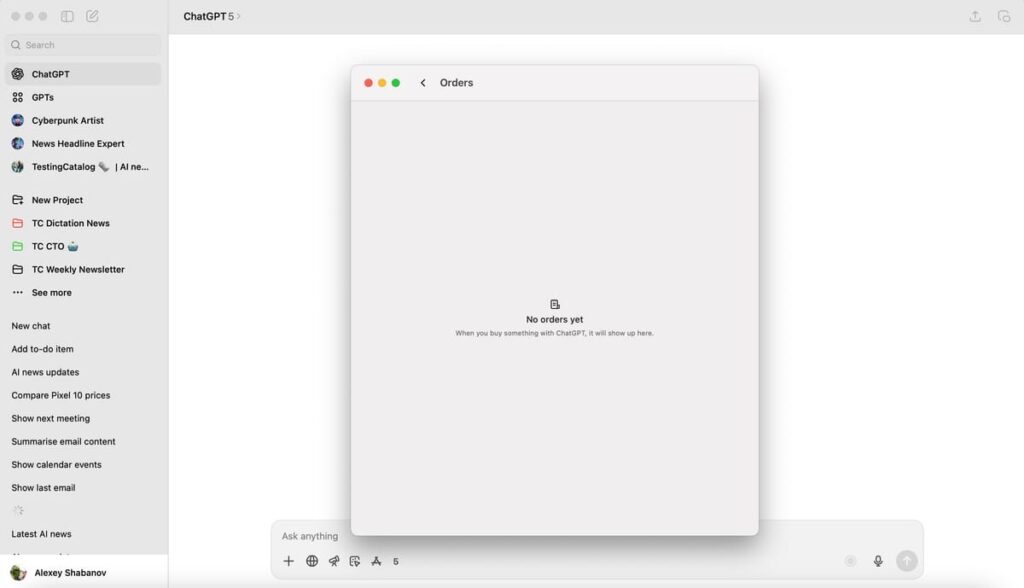OpenAI’s latest updates to the ChatGPT desktop application provide critical insights into how voice functionality and e-commerce integrations could reshape user engagement with AI tools. The enhancements signal a paradigm shift in conversational AI’s role from a predominantly text-based platform to a multifunctional assistant that integrates various productivity and transactional capabilities.
The updated Voice Mode within ChatGPT now operates within the main app window, simplifying user interactions and minimizing disruptions. This enhancement allows for a more seamless user experience. However, the anticipated screen-sharing feature for Voice Mode seems to have been deprioritized, as there has been no progress since its initial unveiling two years ago. This might imply a recalibration of priorities at OpenAI, focusing on core functionalities that directly impact user satisfaction and engagement.
OpenAI’s approach appears to align with broader trends observed in the automation industry, where companies are striving to offer comprehensive solutions that fuse communication with operational capabilities. The introduction of a new “Orders” section within ChatGPT settings suggests that OpenAI is exploring direct purchase functionalities. Early indications point to streamlined payment processes, which would allow users to add credit card information directly to the platform, enabling an efficient transaction landscape. These features are particularly advantageous for small-to-medium business (SMB) leaders, who often require rapid access to digital tools for plugins and services.
In comparing automation platforms, OpenAI’s advancements raise interesting dynamics, particularly in relation to competitors such as Anthropic and established players like Zapier and Make. When examining the costs and returns of these platforms, ChatGPT’s inherent advantages lie in its adaptability and conversational interface, which facilitates a natural dialogue with users. By integrating purchase capabilities, it stands out as a viable option for SMBs seeking to streamline their operations without relying on multiple disparate tools. Traditional automation platforms like Zapier excel in connecting various applications and automating workflows, yet they lack the conversational engagement that ChatGPT offers through its natural language processing capabilities.
Despite these advantages, there are inherent weaknesses to consider. OpenAI’s ChatGPT is still maturing in the context of user interface functionalities, particularly as voiced complaints regarding the absence of anticipated features, like screen sharing, may deter users who seek an all-encompassing solution. Furthermore, while Zapier and Make are established in connecting APIs and managing workflows across platforms, they come with a learning curve regarding setup and may present challenges in scaling complex automation processes for SMBs.
A cost-benefit analysis illustrates that for businesses heavily invested in automating customer interactions and internal processes, the ROI of implementing AI-driven tools like ChatGPT can be substantial. By reducing time spent on repetitive tasks, users can redirect efforts towards strategic initiatives, thereby maximizing productivity and efficiency. As these platforms continue to evolve, it is essential for SMB leaders and automation specialists to weigh initial investment costs against long-term gains in operational effectiveness.
Scalability is another critical component when assessing different platforms. While OpenAI’s ChatGPT is still refining its capabilities, particularly in terms of transaction processing and user interface cohesiveness, its potential for growth is remarkable. In contrast, Zapier and Make offer robust solutions for integrating various services and may already have a more extensive support network for users. Nevertheless, as companies continue to invest in AI solutions, the scalability of tools that merge conversational interfaces with operational functionalities will likely dictate user preferences moving forward.
The development of parental controls within ChatGPT further exemplifies OpenAI’s commitment to addressing user safety and regulatory compliance, particularly as concerns grow around child-centric applications in educational settings. Features like content restrictions and usage limits signal a proactive approach to managing interactions, which could prove invaluable for organizations engaging younger audiences or operating in sensitive environments. The focus on safety and management tools represents a significant opportunity for differentiation in a crowded marketplace where traditional automation platforms may be less equipped to address these emerging needs.
On the whole, the integration of new features within ChatGPT indicates promising avenues for growth and user engagement that could disrupt established offerings in the automation landscape. By lowering transaction friction through internal checkout options, enhancing interactivity with voice features, and introducing safety measures, OpenAI may redefine conversational AI’s role as an operational cornerstone rather than a mere text generation tool.
In conclusion, SMBs and automation specialists may find that the evolving capabilities of ChatGPT present a compelling alternative to traditional platforms like Zapier and Make. The decision to adopt such tools should be guided by an analysis of operational needs, user engagement goals, and the long-term impact on organizational efficiency. As the landscape continues to evolve, agile frameworks that harness the strengths of AI-driven tools will undoubtedly position businesses for sustained success.
FlowMind AI Insight: The convergence of conversational AI and e-commerce functionalities creates an unprecedented opportunity for SMBs to enhance customer interactions and streamline operations. As tools like ChatGPT evolve, organizations that embrace these innovations may find themselves at the forefront of operational excellence and customer satisfaction.
Original article: Read here
2025-09-13 12:29:00

